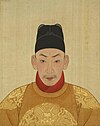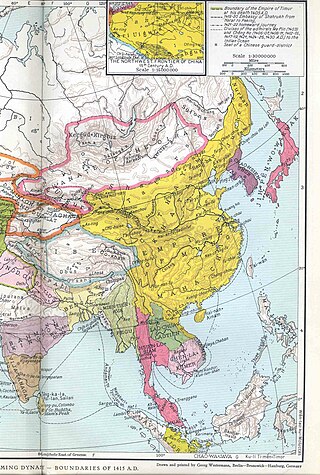
The Ming dynasty, officially the Great Ming, was an imperial dynasty of China, ruling from 1368 to 1644 following the collapse of the Mongol-led Yuan dynasty. The Ming dynasty was the last imperial dynasty of China ruled by the Han people, the majority ethnic group in China. Although the primary capital of Beijing fell in 1644 to a rebellion led by Li Zicheng, numerous rump regimes ruled by remnants of the Ming imperial family—collectively called the Southern Ming—survived until 1662.
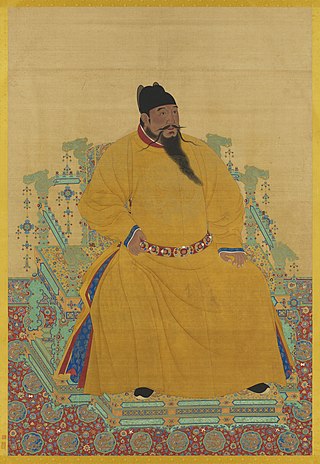
The Yongle Emperor, personal name Zhu Di, was the third emperor of the Ming dynasty, reigning from 1402 to 1424.

The Chenghua Emperor, also known by his temple name as the Emperor Xianzong of Ming (明憲宗), personal name Zhu Jianshen (朱見深), changed to Zhu Jianru (朱見濡) in 1457, was the ninth emperor of the Ming dynasty, who reigned from 1464 to 1487. He succeeded his father, Emperor Yingzong. "Chenghua", the era name of his reign, means "accomplished change".
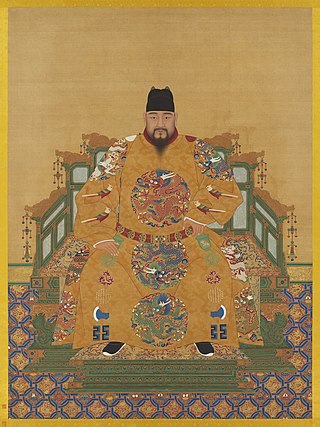
Emperor Yingzong of Ming, personal name Zhu Qizhen, was the sixth and eighth emperor of the Ming dynasty. He ruled as the Zhengtong Emperor from 1435 to 1449, and as the Tianshun Emperor from 1457 until his death in 1464.
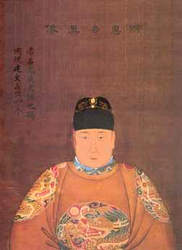
The Jianwen Emperor, personal name Zhu Yunwen (朱允炆), also known by his temple name as the Emperor Huizong of Ming (明惠宗) and by his posthumous name as the Emperor Hui of Ming (明惠帝), was the second emperor of the Ming dynasty, reigned from 1398 to 1402. Zhu Yunwen's father was Zhu Biao, the eldest son and crown prince of the Hongwu Emperor, the founder of the Ming dynasty. Zhu Biao died at the age of 37 in 1392, after which the Hongwu Emperor named Zhu Yunwen as his successor. He ascended the throne after the Hongwu Emperor's death in June 1398.

The Jingtai Emperor, also known by his temple name as the Emperor Daizong of Ming (明代宗) and by his posthumous name as the Emperor Jing of Ming (明景帝), personal name Zhu Qiyu (朱祁鈺), was the seventh emperor of the Ming dynasty, reigned from 1449 to 1457. He succeeded his elder brother, Emperor Yingzong, who had been captured by the Mongols. "Jingtai", the era name of his reign, means "exalted view". He was overthrown in a palace coup led by Yingzong in February 1457, and died a month later.
Zhu Biao was the Hongwu Emperor's eldest son and crown prince of the Ming dynasty. His early death created a crisis in the dynasty's first succession that was resolved by the successful usurpation of his brother Zhu Di as the Yongle Emperor, an act with far-reaching consequences for the future of China.
The Yongli Emperor, personal name Zhu Youlang, was the fourth and last emperor of the Southern Ming dynasty, reigning in turbulent times when the former Ming dynasty was overthrown and the Manchu-led Qing dynasty progressively conquered the entire China proper. He led the remnants of the Ming loyalists with the assistance of peasant armies to resist the Qing forces in southwestern China, but he was then forced to exile to Toungoo Burma and eventually captured and executed by Wu Sangui in 1662. His era title "Yongli" means "perpetual calendar".
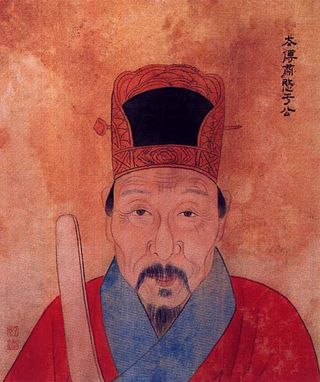
Yu Qian, courtesy name Tingyi (廷益), art name Jie'an (節庵), was a Chinese official who served under the Ming dynasty. Under Emperor Yingzong, he worked in the Ministry of War, eventually becoming a vice minister. He distinguished himself in the Tumu Crisis, leading the defense of the imperial capital against the Mongols, and was promoted to the position of Minister of War. For the next eight years, he remained the most influential member of the government of the new Jingtai Emperor. In January 1457, Yingzong returned to power and Yu Qian was promptly executed.

Zhu Shugui, courtesy name Tianqiu (天球) and art name Yiyuanzi (一元子), the Prince of Ningjing (寧靖王), was a royal member of the Ming and the last of the pretenders to the throne of Southern Ming after the execution of the Yongli Emperor in 1662. He took shelter to the Kingdom of Tungning in Taiwan after mainland China completely fell under the control of Manchu-led Qing dynasty. Despite his status as a royal member, he virtually shared no political power with the Zheng dynasts whom were the actual rulers of the kingdom. After the Qing forces successfully annexed Taiwan in 1683, he committed suicide. Nowadays there is a temple dedicated to the prince in Lujhu Township. Inside the temple is written Zhu's death poem.

The Ming dynasty, officially the Great Ming, founded by the peasant rebel leader Zhu Yuanzhang, known as the Hongwu Emperor, was an imperial dynasty of China. It was the successor to the Yuan dynasty and the predecessor of the short-lived Shun dynasty, which was in turn succeeded by the Qing dynasty. At its height, the Ming dynasty had a population of 160 million people, while some assert the population could actually have been as large as 200 million.
This is a family tree of Chinese monarchs from the Yuan dynasty to the end of the Qing dynasty.
Zhu Gaoxu was the second son of the Yongle Emperor and Empress Renxiaowen. During the Jingnan campaign, which brought his father to the throne, he proved himself to be a capable military leader. In 1426, he revolted against his nephew, the Xuande Emperor, but was quickly defeated and executed.
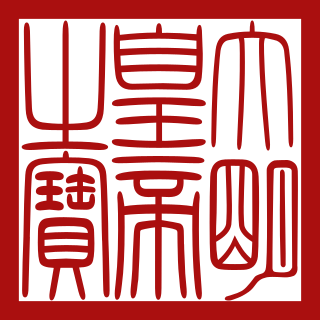
The House of Zhu was a Chinese imperial ruling house of the Ming dynasty (1368–1644) and Southern Ming dynasty (1644–1662). They also held the title "Duke of Wu" and "King of Wu" from 1361 to 1368 as well as "Marquis of Zhu" from 1725 to 1929.

Empress Xiaogongzhang, of the Sun clan, was a Chinese empress consort of the Ming dynasty, married to the fifth Ming emperor, the Xuande Emperor. She was mother of Zhu Qizhen, Emperor Yingzong.
Imperial Noble Consort Wan (1428-1487), born Wan Zhen'er, was an imperial consort during the Ming dynasty. She is sometimes known as Consort Wan or Lady Wan and was the favorite consort of the Chenghua Emperor. She was approximately fifteen to seventeen years older than the emperor.
Taizi was the title of the crown prince of imperial China.

Ming Dynasty is a 2019 Chinese television series giving a fictionalised account of the life of Empress Sun, who was an empress consort of the Xuande Emperor. Starring Tang Wei and Zhu Yawen, it aired on Hunan Television until 2020. Loosely adapted from the novel The Chronicle of the Six Eras by Lianjing Zhuyi, the show gained much attention and viewership from non-Chinese viewers after it achieved high ratings in mainland China.

Empress Xiaosu, of the Zhou clan, was the concubine of Emperor Yingzong of Ming and the mother of the Chenghua Emperor.










